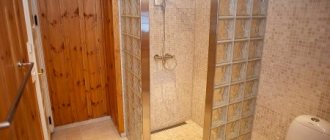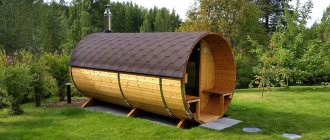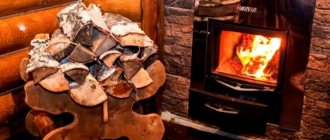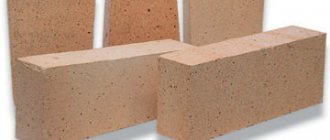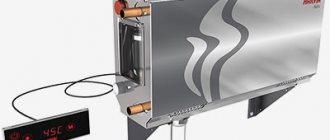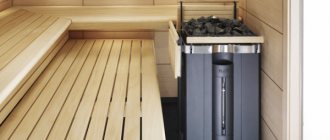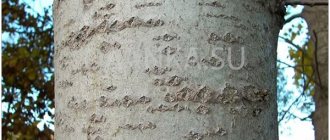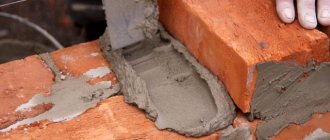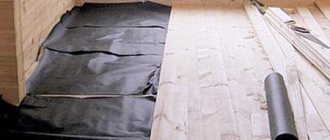The standards for building a bathhouse on a site are quite numerous, and this is not without reason: this is the only way to ensure the proper level of safety and durability of all building structures.
In order to choose the optimal location of the building and not violate the norms of SNiP and the requirements of various supervisory authorities, it is necessary to familiarize yourself with the relevant regulations or consult with competent specialists. This will avoid mistakes and costs for eliminating various violations.
>
In the photo, the distance between the bathhouse and the fence should be 2.5 meters
If a design organization is planning the location of buildings on your site, then there is nothing to worry about - all requirements and standards will be met, but if you do everything yourself, then you should familiarize yourself with the basic requirements before drawing up a site plan.
Documents regulating the rules for building baths on the site
As you know, both in residential and garden areas, the distances between buildings must meet the requirements that are regulated by the following documents:
- SNiP 30-02-97, which contains complete information on the basic rules for planning and development of garden and personal plots. This is the main document that every developer needs to study most carefully.
- SP 11-106-97 - this regulatory act will help you create a site development project that will comply with all basic standards, which will save you from alterations and improvements in the future. In addition, after studying this act, you will know all the intricacies of the approval and approval procedure - where to go, what to provide and how to speed up the process.
Let's look at the basic requirements in more detail.
The process of creating a wall pie
Stages of insulation of the living room.
The outer covering must be laid on the sheathing to create a gap for ventilation (the condensate will evaporate and not accumulate). It is unacceptable to place the outer shell on the membrane to prevent sticking of the insulation material with the shell and its sagging.
After the frame is built, it is necessary to remove the internal frame, vikorist boards with a thickness of approximately 2-3 centimeters. It is best to pick up wood so that it does not rot when exposed to moisture, such as linden, wasp, and modrina. Selected sheets are nailed behind additional flowers to stand vertically on the beams. To finish each part, a wooden lining is put together, which helps to enhance the entire structure, and not just create a nice look.
As a vapor-insulating material, special spitting or parchment can be dried. The spitting area is lined with foil up to the placement side to allow for more heating. This material is simply necessary for laying frames in order to prevent staining of moisture and condensation on the internal walls.
Before vapor insulation, insulation is applied to ensure the required level of thermal insulation. The waterproofing is attached directly to the beams. Next, sheathing of the outer walls is carried out using additional sheets of DSP or OSB, attaching them to the beams. The outer walls of the hall are sheathed with additional lining, siding, block house, boards to give the structure a proper appearance.
We invite you to familiarize yourself with a DIY chimney for a bathhouse
Fire safety - basic requirements
Fire safety standards should be strictly observed when building a bathhouse, because any violations can lead to a fire in the room.
First of all, you should take care of the safety of the stove, since this is by default the most important part of the bathhouse. The walls of the oven should not heat up to a temperature exceeding 120 degrees.
All walls of the building adjacent to the stove must be additionally protected from high temperatures using several methods:
- Plastering with cement mortar on a metal mesh.
- Sheet of galvanized sheet over moderately fire resistant surfaces.
- The entire contact area between wooden walls must be covered with asbestos cardboard.
Basic fire safety standards
A sheet of tin measuring no less than 50*70 must be attached to the floor in front of the firebox. Much attention is also paid to chimneys, which must have grooves in places where they pass through ceilings and retreats when burning structures are close to each other.
In addition, it is best to additionally protect the junction of the chimney with the ceiling with a sand trap around the perimeter at a distance of approximately 70 cm. This will protect the building from sparks if cracks occur in the chimney.
Advice: the chimney is the most dangerous place in a building, so after completing the work it is wise to invite a competent specialist who will inspect the quality of the structures. This will ensure that the chimney is safe.
Fire safety regulations prohibit the use of asbestos or metal pipes as a chimney in a bathhouse due to their danger and high surface temperature. The exception is the pipes of the coaxial system, that is, inside the large pipe there is a smaller pipe, and the space between them is filled with fire-resistant heat-insulating material (most often it is stone wool).
It is unnecessary to remind that all baths must be equipped with fire shields or, at a minimum, must have fire extinguishers.
Making the foundation
Formwork
After the trenches for the foundation have been dug and the water and sewer pipes have been filled in, you can begin making the formwork for the foundation. To do this, using a water level or a laser plane builder, we set all the lacings stretched on the pegs (those that delineated the boundaries of the trenches) at the same level with the height of the future base. It is based on this lacing that the walls of the formwork are mounted.
It is still best to use edged boards as a building material, rather than OSB, which is popular today. Firstly, the board is stiffer and the resulting wall of the plinth is much smoother than one cast in formwork made of sheet material. And, secondly, after dismantling, the boards can be used for other purposes, while OSB cut into pieces will most likely have to be thrown away.
Important: Many people neglect to be careful when laying out the foundation formwork, they say, the base will still be covered. But the more carefully you do the work now, the less effort you will have to put in later.
The formwork structure is made quite rigidly in order to prevent its destruction or deformation under the pressure of poured concrete.
Reinforcement
In most cases, the detailed design will indicate the reinforcement required for the foundation. For ease of work, the reinforcement cage can be tied on the ground and lowered into the trench in its finished form. But it must be manufactured strictly according to the working design, and not just as it is necessary. Proper reinforcement is the basis of the entire foundation, and therefore the entire building, and you should not neglect the instructions of the working design.
You can easily assemble the metal frame itself, consisting of reinforcement, yourself (for this you will only need a grinder, wire, wire cutters with pliers and a welding machine), while only an accurate engineering calculation will help you calculate the correct location of the reinforcement in the concrete foundation.
Important: Reinforcement placed in the foundation at random, without preliminary calculations, will not be able to give the reinforced concrete structure being manufactured the required design capacity, which means that the structure itself being built on such a foundation will be under threat.
sand cushion
Before lowering the reinforced frame into the trench and starting to fill it all with concrete, it is necessary to make a sand cushion under the foundation. For such a light structure as a bathhouse, a layer of sand of 100 mm will be enough.
You need to fill the sand in layers, gradually moistening it and compacting it. A properly made sand cushion is a kind of shock absorber between the building and the ground. Its role is especially important in the case of manufacturing a shallow strip foundation, since it helps to combat such an unpleasant phenomenon as soil heaving.
Concreting
For concreting itself, ready-mixed concrete grade M-200 is quite suitable. You can either order it or make it yourself in a concrete mixer. It is produced in the following proportions: one volume of M-400 cement, two volumes of sand and five volumes of crushed stone of the 35th fraction. Whether to buy or mix it yourself is up to the developer to decide based on the prices of ready-made concrete and its components in his region.
The thicker the resulting concrete, the higher the quality of the products made from it, but also the more difficult it is to work with. Although, if you have a vibrating hose, this will greatly facilitate any concrete work.
Unfortunately, it is not possible to determine at home the amount of water required to make the required thickness of the solution, since the sand may initially have different humidity levels. So you will have to work based on personal experience.
It is necessary to pour concrete into the formwork to the edges (the formwork was initially set according to the level and required height), compacting it during the pouring process and carefully leveling the resulting top edge.
After 5–7 days, the formwork can be removed. Concrete that has gained 70% of its strength is not so easy to destroy. But it is still recommended to carry out subsequent construction work in about a month. While the foundation is standing, do not forget to moisten it daily, concrete loves moisture.
In the next part we will tell you exactly what kind of wall pie to prepare for your bathhouse. How to properly make a roof, and what material to use to insulate a steam room. In the meantime, while the foundation is standing, you can rest a little.
Where should the bath be located?
There are certain standards for building a bathhouse on a plot of land, compliance with which is regulated by regulations. Violation of these provisions is highly undesirable and may result in the most severe sanctions from supervisory authorities.
Distances from buildings to the fence
So, there are the following standards for the construction of a bathhouse from a fence:
- According to the standards, the distance must be at least 3 meters, this is due to the peculiarities of draining wastewater from the building. The optimal solution is a separate drain or gutter, in which case the distance to the fence can be reduced to 2.5 meters.
- Any deviations from the norms must be agreed upon between neighbors in writing to avoid problems in the future when the owner of the property changes.
- In any case, the distance to the fence should not be less than 1 meter; this minimum permissible distance must be observed.
You should not save space between the bathhouse and the fence in order to avoid violation of norms and requirements
In addition to the distance to the fence, there are other standards for the location of the bathhouse on the site:
- The distance from the residential building to the bathhouse must be at least 8 meters.
- There must be a distance of at least 12 meters from the well to the bathhouse building.
- If the bathhouse is located on a dacha or garden plot, then the borders of the neighboring plot must be at least 8 meters.
Northern summer resident - News, Catalog, Consultations
New sanitary and epidemiological requirements for the placement, design, equipment, maintenance and operating hours of public baths and saunas were approved by Rospotrebnadzor. They come into force on June 2.
From now on, baths and saunas are prohibited from opening in multi-apartment residential buildings, including basements and basements. They can now only be located in separate buildings. It was also decided to fight against microbes, fungi and infections.
The premises must maintain strict microclimate parameters: in the locker room the air temperature is 25-28 degrees, in the soap room - not lower than 25 degrees. And cleaning in the baths must be done throughout the working day. Moreover, once a week - general cleaning and disinfection. The ventilation system will be cleaned and disinfected at least once a year. In locker rooms and soap rooms, containers with lids should be installed to collect used linen and bath accessories. At the same time, sanitary doctors do not object if the bathhouses have not only beauty salons for manicure and pedicure, massage, hairdressing and cosmetic services, but also laundries, bars, cafes, restaurants, and shops. And even swimming pools - subject to compliance with the requirements of sanitary legislation.
The new rules oblige the owners of baths and saunas to change the furniture - soft sofas and armchairs have no place there. Finishing materials, bathtubs, basins must also be made of materials that are resistant to corrosion and treatment with disinfectants. The number of cans is also calculated. For one place in the soap bar there should be two basins - for the legs and for the body. Basins for washing feet must be marked “For feet.” Standards have been established for water taps and showers with mixers at the rate of one tap and one shower for no more than 8 people.
Bathhouse attendants and other wash house workers must not only be examined at least once every two years and have personal medical records with information about past infectious diseases, but also undergo professional certification. Industry participants say most of these standards are still being followed. But with the registration of the departmental order in the Ministry of Justice, they acquired the status of mandatory execution and control. Industry experts note that the innovations will lead to the fact that the owners of many “savory” saunas that currently operate in the basements of residential buildings will have to change their registration or name.
By the way, new baths must now be designed, built or reconstructed according to the hygienic principle of flow - this is when guests move in a strict sequence - wardrobe, dressing room, soap room, steam room. Bathrooms are located next to the dressing rooms. The inspectors will have no complaints in this regard regarding bathhouses in old buildings - they were allowed to operate in accordance with the design according to which they were built.
Document text
Resolution of the Chief State Sanitary Doctor of the Russian Federation dated December 20, 2013 N 70, Moscow “On approval of SanPiN 2.1.2. 3150-13 “Sanitary and epidemiological requirements for the placement, design, equipment, maintenance and operating hours of baths and saunas”"
Registered with the Ministry of Justice of the Russian Federation on May 13, 2014.
Registration N 32244
In accordance with the Federal Law of March 30, 1999 N 52-FZ “On the sanitary and epidemiological welfare of the population” (Collected Legislation of the Russian Federation, 1999, N 14, Art. 1650; 2002, N 1 (Part 1), Art. 2; 2003, N 2, article 167; N 27 (part 1), article 2700; 2004, N 35, article 3607; 2005, N 19, article 1752; 2006, N 1, article 10; N 52 (Part 1), Article 5498; 2007 N 1 (Part 1), Article 21; N 1 (Part 1), Article 29; N 27, Article 3213; N 46, Article 5554; N 49, Article 6070; 2008, N 24, Article 2801; N 29 (Part 1), Article 3418; N 30 (Part 2), Article 3616; N 44, Article 4984; N 52 (Part 1), Article 6223; 2009, N 1, Article 17; 2010, N 40, Article 4969; 2011, N 1, Article 6; N 30 (Part 1), Article 4563; N 30 (Part 1), Article 4590; N 30 (Part 1), Article 4591; N 30 (Part 1), Article 4596; N 50, Article 7359; 2012, N 24, Article 3069; N 26 , Art. 3446; 2013, N 27, Art. 3477; N 30 (part 1), Art. 4079; N 48, Art. 6165) and the Decree of the Government of the Russian Federation dated July 24, 2000 N 554 “On approval of the Regulations on state Sanitary and Epidemiological Service of the Russian Federation and the Regulations on State Sanitary and Epidemiological Standardization" (Collected Legislation of the Russian Federation, 2000, No. 31, Art. 3295; 2004, N 8, art. 663; N 47, art. 4666; 2005, N 39, art. 3953) I decree:
Approve sanitary and epidemiological rules and regulations SanPiN 2.1.2. 3150-13 “Sanitary and epidemiological requirements for placement, equipment, maintenance and operating hours of baths and saunas” (appendix).
Acting Chief State Sanitary Doctor
Russian Federation
A. Popova
Application
Sanitary and epidemiological requirements for placement, equipment, maintenance and operating hours of baths and saunas
Sanitary and epidemiological rules and regulations SanPiN 2.1.2.3150-13
I. Scope and general provisions
1.1. These sanitary and epidemiological rules and regulations (hereinafter referred to as the sanitary rules) establish mandatory sanitary and epidemiological requirements for the design, equipment and maintenance of all types of public baths and saunas (hereinafter referred to as the baths).
1.2. These sanitary rules do not apply to facilities that are in the design, construction, reconstruction and commissioning stages at the time these sanitary rules come into force.
Previously constructed bathhouse buildings are operated in accordance with the project according to which they were built.
1.3. Control over the implementation of these sanitary rules is carried out in accordance with the legislation of the Russian Federation by bodies authorized to carry out federal state sanitary and epidemiological supervision1.
II. Sanitary and epidemiological requirements for the placement and construction of baths
2.1. Baths should be located in separate buildings. The installation of bathhouses in multi-apartment residential buildings is not allowed.
2.2. When designing, constructing and reconstructing baths, the internal layout of the main premises must comply with the hygienic principle of flow, which provides for the possibility of sequential movement of visitors according to the scheme: wardrobe, dressing room, soap room, steam room. Bathrooms are located next to the dressing rooms.
2.3. In the baths it is allowed to place: premises for the provision of services - manicure and pedicure, massage, hairdressing and cosmetic services; laundries; catering facilities, retail trade, swimming pools - subject to compliance with the requirements of sanitary legislation for their placement, design, equipment and operation.
2.4. Bathhouse buildings are equipped with hot and cold water supply, sewerage, heating, and ventilation systems. To achieve optimal microclimate parameters, the installation of air conditioning systems is allowed.
2.5. Cleaning and disinfection of mechanically driven supply and exhaust ventilation systems should be carried out at least once a year.
2.6. In the absence of a centralized sewerage system, bathhouse buildings are equipped with local treatment facilities.
2.7. Bath water supply systems must ensure an uninterrupted supply of cold and hot water that meets the sanitary and epidemiological requirements for water quality of centralized drinking water supply and hot water supply systems.
2.8. Lighting in bathhouses must comply with hygienic requirements for natural, artificial and combined lighting of residential and public buildings.
III. Sanitary and epidemiological requirements for equipment, maintenance and operating hours of baths
3.1. To decorate bathhouses, materials are used that are resistant to moisture, temperature, detergents and disinfectants.
3.2. Furniture installed in bathhouses must have smooth surfaces that are accessible for wet cleaning and resistant to treatment with disinfectants.
3.3. Changing rooms must be provided with separate seats and hangers for the clothes of each visitor.
3.4. Soap bars are equipped with benches made of materials that are resistant to moisture and disinfectants.
Soap rooms are equipped with water taps and showers with mixers at the rate of one tap and one shower for no more than 8 people. It is recommended to provide a separate tap in the soap room with hot and cold water supply for washing walls, equipment and floors.
3.5. Baths and basins intended for washing must be made of materials that are resistant to corrosion and treatment with disinfectants. The number of cans is taken at the rate of at least two cans per washing area. Basins intended for washing feet must be marked “For feet.”
3.6. Steam rooms are equipped with shelves or seats. The steam room is decorated with materials that are safe for humans.
3.7. The staff room is equipped with individual lockers for separate storage of personal clothing and workwear of bathhouse workers.
3.8. The following microclimate parameters must be maintained in the bathhouse premises: in the dressing room - the air temperature is 25 - 28 C, in the soap room - not lower than 25 C.
3.9. Separate rooms (hereinafter referred to as linen rooms) must be allocated for storing clean and used linen.
3.10. Linen rooms for storing clean linen must be equipped with closed cabinets or racks at a height of at least 30 cm from the floor, with a coating that allows wet cleaning and disinfection.
3.11. Linen rooms for storing used linen must be equipped with racks at a height of at least 30 cm from the floor, with a coating that allows wet cleaning and disinfection.
When storing used linen for more than a day, provision must be made for drying the used linen.
3.12. In dressing rooms and soap rooms, containers with lids should be installed to collect used linen, brooms, and bath accessories.
3.13. Baths are provided with cleaning equipment, which must be marked and used in accordance with the marking depending on the purpose of the premises (toilet, entrance group of premises, soap and steam room, dressing room), stored in specially designated areas or in a separate closet.
3.14. During the working day, routine cleaning should be carried out in the bathhouse premises: washing the floors, benches in the dressing rooms, as well as washing the floors, benches with a hose in the soap and steam rooms. At the end of the working day, in the absence of visitors in the bathhouse, all premises are cleaned using disinfectants.
3.15. Once a week a day is allocated for general cleaning. During general cleaning, the surfaces of floors and walls in all rooms, as well as benches in changing rooms, soap rooms and steam rooms, are washed using disinfectants.
Elimination of current finishing defects (elimination of leaks on walls and ceilings, cracks, crevices, etc.) is carried out during general cleaning.
3.16. Deratization and disinfestation are carried out at least once a month.
3.17. Waste generated as a result of bathhouse activities must be collected and disposed of.
3.18. Bathhouse workers must undergo preliminary, upon employment, and periodic medical examinations in the prescribed manner2; certification for knowledge of these sanitary rules at least once every 2 years.
Bathhouse workers must be vaccinated in accordance with the national calendar of preventive vaccinations, as well as according to epidemic indications3.
Each bathhouse employee must have a personal medical record, which must contain the results of medical examinations and laboratory tests, information about vaccinations, previous infectious diseases, information about undergoing professional hygienic training and certification, and permission to work.
3.19. Bathhouse workers must be provided with special clothing and personal protective equipment. Laundry of work clothes must be organized.
1Resolution of the Government of the Russian Federation dated 06/05/2013 N 476 “On issues of state control (supervision) and invalidation of certain acts of the Government of the Russian Federation” (Collected Legislation of the Russian Federation, 2013, N 24, Art. 2999)
2Order of the Ministry of Health and Social Development of Russia dated April 12, 2011 N 302n “On approval of lists of harmful and (or) hazardous production factors and work, during the performance of which mandatory preliminary and periodic medical examinations (examinations) are carried out, and the Procedure for conducting mandatory preliminary and periodic medical examinations (examinations) workers engaged in heavy work and in work with harmful and (or) dangerous working conditions" (registered by the Ministry of Justice of Russia on October 21, 2011, registration N 22111, as amended by order of the Ministry of Health of Russia dated May 15, 2013 N 296n, registered by the Ministry of Justice of Russia on July 3. 2013 N 28970).
3Order of the Ministry of Health of Russia dated March 21, 2014 N 125n “On approval of the national calendar of preventive vaccinations and the calendar of preventive vaccinations for epidemic indications” (registered by the Ministry of Justice of Russia on April 25, 2014, registration N 32115).
www.rg.ru
| < Previous | Next > |
Sanitary requirements for the construction and operation of a bathhouse
As is known, sanitary standards for baths affect mainly public institutions, while structures for personal use are affected much less, which often leads to violation of various norms and rules that affect the quality of recreation and safety of operation.
Basic sanitary standards for the construction of buildings on the site
What needs to be considered during the construction process
- The instructions for a public bath pay great attention to a high-quality ventilation system; this is no less important in small buildings, because the durability of the structures and the quality of their drying directly depend on this. In addition, musty air is not conducive to a good rest in the steam room.
- The installation of high-quality drainage is also important; defects can lead to the appearance of fungus and the proliferation of various pathogenic bacteria.
Advice: you should not skimp on materials for thermal insulation of the steam room; the durability of the structure and the quality of ventilation directly depend on them. The low price of insulation is the first indicator of its low quality.
Why compliance with sanitary and building codes is so important
During construction, first of all, it is necessary to take into account all the features of the project. It is worth understanding that compliance with all standards is intended to ensure the maximum level of safety during operation, as well as ensuring the best quality of rest. Any deviations can reduce the benefits of bath procedures and make staying in the steam room dangerous.
All distances between objects should be carefully checked
Exterior wall decoration
It doesn’t matter that a frame sauna will be an inexpensive option for a bathhouse, it can be given a very expensive and exclusive appearance, and you don’t have to get by with just painting the walls. Thanks to a large number of modern building materials, you can give the bathhouse walls a decent appearance. The external walls can be finished with thermal panels, facing bricks, vinyl siding, or block house.
We invite you to familiarize yourself with high-quality finishing of a bathhouse with your own hands
What is important here is the imagination of the master, who can make a beautiful and functional room from a frame version of a bathhouse.
Source
Conclusion
Having studied the regulations indicated in the article and applied in practice all the requirements described above, you can easily cope with both the design and the tedious process of coordination and approval of the project. Only after this can you proceed directly to construction work (see also the article “Construction of a bathhouse: features and recommendations”).
The video in this article will help you understand this issue even better.
Did you like the article? Subscribe to our Yandex.Zen channel
What are the advantages of the frame structure?
Attachment to the inner part of the frame wall.
Vapor barrier and insulation of the living room
Construction of the crawl space wall with vapor barrier.
To insulate the walls, it is necessary to use rolled ursa with a thickness of 50 mm. It is laid between the racks, spread vertically, with the slats nailed down to them. In some places, it is allowed to nail directly to the outside of the boards, but only with the help of special bolts, which have a humic washer under the head.
A negative thing for the frame lazna is that it is necessary to take a winter bath if it is hot in the lazna. For such moments, vapor barrier is necessary. At the moment, the best option is polyethylene melt, which should be placed under the inner lining.
It is important to note that the steam room requires clear vapor barrier lining. A good use for this type of vapor barrier is aluminum foil, vapor barrier foam, parchment and other materials. For this application, it is necessary to use tar paper or roofing felt due to the specific smell that will be seen when heated.
In this manner, a wall pie emerges, which is formed from the stepping balls:
- ball of external lining;
- glassine ball;
- insulation ball;
- a ball of polyethylene spit;
- ball of internal lining.
It is very important to leave a small gap of 5 cm in the middle of the wall.
Rules for creating walls and order of actions
A frame wall with additional insulation.
Before the beginning of the development of the frame plant, it is necessary to reconfigure the wood that has been harvested in the work in full readiness. Vaughn is guilty of being thoroughly dried. The type of wood, whatever it may be, can rely on the power of this food. Golovny - do not pick up the birch in the robot, as it is already very rotten, and all the trees should be suitable for the robot. Most often the choice falls on linden, modrina or wasp, which are characterized by low thermal conductivity and the difficulty of preserving shape.
For the external cladding, it is better to use pine or modrine, and for the internal cladding, all types of wood are suitable, but in most cases, aspen is used.
After all work is completed, the outer boards must be coated with an antiseptic, and the inner lining, if possible, must be sanded and then coated with furniture varnish, using two balls. There will be a special leakage, which is necessary for all areas, except the walls in the room and the steam room.
The bottom binding will be smaller if it is made from a mitered beam, or a beam with a 10x10 cm crossbar will be used. Once the bottom binding is removed and securely fastened, the racks must be placed on steel bars so that they will not move.
The simplest and most accessible material for the external cladding of a walkway is lining (either imitation or decorative). The lining of the lining along the outer wall is laid horizontally, placing parchment in front, which will serve as waterproofing. The leaves need to be overlapped and sealed with tape to prevent the moisture from penetrating into the middle.
Exterior wall finishing
It doesn’t matter that a frame sauna is an inexpensive option for relaxation, it can be given an even more expensive and exclusive modern look, and you don’t have to deal with simple walls. With a large number of everyday materials, you can give the walls of the garden a new, modern look. The walls on the outside can be covered with thermal panels, cladding, vinyl siding, or block house.
What is important here is the master’s imagination, which can be used to create a beautiful and functional space from the frame version of the window.
